|
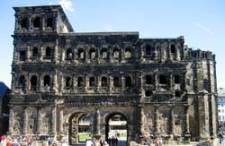 We got up around 8:30, made some instant espresso, which we had gotten from our B&B in Amsterdam, and drove down to Trier.
Trier is the oldest city in Germany. It was founded in 16 BC by the Roman Emperor Augustus.
According to Via Michellin,
this drive is 109km. When we arrived at Trier we had a little trouble finding a place to park, but eventually we found the garage
we had been looking for, which was just outside the original city walls to the west of the Porta Nigra.
Porta Nigra was the most northern of five gates integrated into Trier's original city wall, which was four miles long and enclosed a space of 687 acres.
The Porta Nigra is the sole gate to have survived the demolition of the rest of the city's Roman fortifications during the Middle Ages because
it was converted into a church in honor of St. Simeon. Before visiting the Porta Nigra we got a quick meal, Bratwurst mit Br�tchen and Currywurst mit Pommes, at a small cafe.
We got up around 8:30, made some instant espresso, which we had gotten from our B&B in Amsterdam, and drove down to Trier.
Trier is the oldest city in Germany. It was founded in 16 BC by the Roman Emperor Augustus.
According to Via Michellin,
this drive is 109km. When we arrived at Trier we had a little trouble finding a place to park, but eventually we found the garage
we had been looking for, which was just outside the original city walls to the west of the Porta Nigra.
Porta Nigra was the most northern of five gates integrated into Trier's original city wall, which was four miles long and enclosed a space of 687 acres.
The Porta Nigra is the sole gate to have survived the demolition of the rest of the city's Roman fortifications during the Middle Ages because
it was converted into a church in honor of St. Simeon. Before visiting the Porta Nigra we got a quick meal, Bratwurst mit Br�tchen and Currywurst mit Pommes, at a small cafe.
Before exploring the city, we decided to stop at the TI (Tourist Information). We bought the "Experience Trier: The NEW City Guide" for 5.50 EUR.
We also met an American in the TI office. He was from Washington state and was revisiting Germany after being stationed there with the military years 30 years earlier.
He said he was working on a mystery novel set in Trier.
 After visiting the Porta Nigra, we followed the tour in our city guide, visiting the
historical structures of Trier. The House of the Three Magi is one of the oldest surviving secular buildings in Trier, built around 1230.
We stopped at St. Gangolf (1459)
before continuing to the Dom und Liebfrauen (Cathedral and Church of Our Lady).
After visiting the Porta Nigra, we followed the tour in our city guide, visiting the
historical structures of Trier. The House of the Three Magi is one of the oldest surviving secular buildings in Trier, built around 1230.
We stopped at St. Gangolf (1459)
before continuing to the Dom und Liebfrauen (Cathedral and Church of Our Lady).
Inside the Dom is a reliquary that some believe holds the seamless robe of Jesus. According to
Wikipedia, "The seamless robe of Jesus is the robe said to have been worn by Jesus during his crucifixion.
According to the Gospel of John, the soldiers who crucified Jesus did not divide his tunic after crucifying him, but cast lots to determine who
would keep it because it was woven in one piece, without seam. The tradition of the Roman Catholic Church holds that that robe is now housed in
the cathedral of Trier, Germany. The historical record supporting the identification of this relic as genuine is not proven."
After leaving the Dom, we realized there were more things that we wanted to do in Trier than we had time for, so we decided to skip the Liebfrauen,
and hope to see it on the way back to our car. Also, we knew the Liebfrauen was open later than the other things we were interested in.
Our next destination was the Kaiserthermen, but there were some other interesting sights along the way. First, we passed the
Palais Kesselstatt,
which follows the curve of the street and has a curved projection and gable. It was erected for chief bailiff Karl Friedrich Melchior Count
Kesselstatt in 1746.
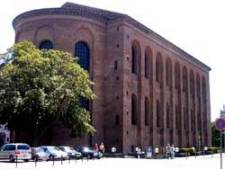 The Basilika was built on the site of an earlier greeting hall for the Roman Emperors who resided in Trier in the 3rd and 4th century.
This Basilika
was completed during the reign of the Roman Emperor Gratian (367-383). The Basilika is 71.5 m (236 ft) long and 32.6 m (208 ft) wide. Originally
it did not have a brick exterior, but was coated in plaster to which brick chippings had been added to give it a reddish tinge. The Basilika even
had a hollow floor and walls for its heating system.
The Basilika was built on the site of an earlier greeting hall for the Roman Emperors who resided in Trier in the 3rd and 4th century.
This Basilika
was completed during the reign of the Roman Emperor Gratian (367-383). The Basilika is 71.5 m (236 ft) long and 32.6 m (208 ft) wide. Originally
it did not have a brick exterior, but was coated in plaster to which brick chippings had been added to give it a reddish tinge. The Basilika even
had a hollow floor and walls for its heating system.
The Basilika was expanded in the 17th century when the Kurf�rstliches Palais (Electoral Palace), a monumental four winged renaissance palace, was
added. Only two wings of the building survived the destruction of World War II. Our guide book claimed that "one of the most beautiful staircases
in rococo" was located in the south wing, although it looked like the building was closed
while we were there.
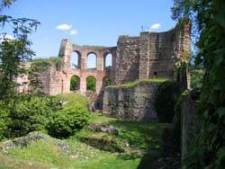 Construction of the Kaiserthermen (Imperial Baths) began in the late 3rd century.
In 312, before its completion,
Constantine turned his political interests to the Mediterranean,
and abandoned the construction of the Kaiserthermen. The Kaiserthermen sat unfinished until the mid-century when historians believe it was
converted into barracks for the mounted imperial bodygaurds. With the departure of the Roman administration around the late 4th or
early 5th century, the Kaiserhermen was abandoned. In the early Middle Ages it was remodelled into a castle, and in 1120, became part of the
medieval city wall. We paid a couple of Euros each to walk around the ruins.
Construction of the Kaiserthermen (Imperial Baths) began in the late 3rd century.
In 312, before its completion,
Constantine turned his political interests to the Mediterranean,
and abandoned the construction of the Kaiserthermen. The Kaiserthermen sat unfinished until the mid-century when historians believe it was
converted into barracks for the mounted imperial bodygaurds. With the departure of the Roman administration around the late 4th or
early 5th century, the Kaiserhermen was abandoned. In the early Middle Ages it was remodelled into a castle, and in 1120, became part of the
medieval city wall. We paid a couple of Euros each to walk around the ruins.
One of the sites we wanted to be sure to see was the Stadtbibliothek (City Library) which contained many ancient texts from the last 1200 years.
Unfortunately, we were never able to get into the Stadtbibliothek. We think we found it, but after examining the map and trying to translate a sign
on its door, we finally decided that it was closed for reconstruction.
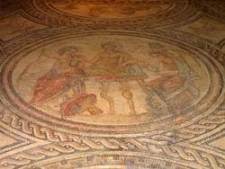 After realizing we could not get into the Stadtbibliothek, we decided we had time to see one more museum in Trier. The Rheinisches Landesmuseum
(Roman Archeological Museum) was nearby, so we decided to go there. The receptionist did not speak
any English, but we were able to determine that we needed to put our rucksack in a locker.
The museum had a large collection of Roman artifacts, including sculptures of Roman heads and Roman mosiacs, as well as Germany's largest
collection of coins from antiquity. Unfortunately, almost all of the exhibits were only in German, so we often had to guess what we were
looking at.
After realizing we could not get into the Stadtbibliothek, we decided we had time to see one more museum in Trier. The Rheinisches Landesmuseum
(Roman Archeological Museum) was nearby, so we decided to go there. The receptionist did not speak
any English, but we were able to determine that we needed to put our rucksack in a locker.
The museum had a large collection of Roman artifacts, including sculptures of Roman heads and Roman mosiacs, as well as Germany's largest
collection of coins from antiquity. Unfortunately, almost all of the exhibits were only in German, so we often had to guess what we were
looking at.
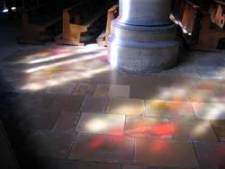 We stopped at the Liebfrauen on the way back to the market square. Inside the Liebfrauen, the sunlight through the stained glass windows
cast a beautiful shadow. The interior of the Liebfrauen was under renovation when we were there, and most of it was undercover
or blocked by construction.
We stopped at the Liebfrauen on the way back to the market square. Inside the Liebfrauen, the sunlight through the stained glass windows
cast a beautiful shadow. The interior of the Liebfrauen was under renovation when we were there, and most of it was undercover
or blocked by construction.
We returned to the Trier market square to look for a place to eat lunch. There were a wide array of restaurants at the square, including
McDonalds and Subway. We decided to eat at a Turkish Kebab cafe. We attempted to order one serving of the second menu item, by saying
"zwei", but we realized they thought we wanted two servings. We clarified
"nur eins", and we ended up with what we think was one
serving of the first menu item. Regardless, the gyro was delicious.
The gyro and a can of Lift (Coca-Cola apple drink) cost us less than 5 EUR. We sat near the fountain in the center of the market square
and ate our lunch. The fountain dates from the late 16th century, and its figures represent the cardinal virtues.
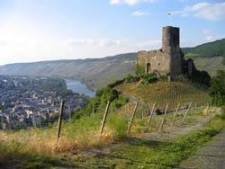 After finishing the sandwich, we purchased a kugel of vanilla and mocha ice cream
to share on the way back to our car. We still had a few hours before dark, so we decided to drive up the Mosel River to Burg Landshut before heading home2. While
driving along the Mosel River we were amazed by the vineyards that seemed to cover every square foot of river bank. We made a few wrong turns, but
eventually found our way to Burg Landshut. Burg Landshut was the property of the Arch-Bishops of Trier from the 11th century, and has laid in ruin since the War of
the Orl�ans succession. The ruins were on the top of a hill overlooking the Bernkastel-Kues and surrounded by vineyards.
There was a cafe in the ruins that should have been open for another five minutes after we arrived, but had closed early, so we just looked around for
a while before driving back to the timeshare. Near Burg Landshut was a nice looking hostel that we decided to keep in mind for future trips to the area.
After finishing the sandwich, we purchased a kugel of vanilla and mocha ice cream
to share on the way back to our car. We still had a few hours before dark, so we decided to drive up the Mosel River to Burg Landshut before heading home2. While
driving along the Mosel River we were amazed by the vineyards that seemed to cover every square foot of river bank. We made a few wrong turns, but
eventually found our way to Burg Landshut. Burg Landshut was the property of the Arch-Bishops of Trier from the 11th century, and has laid in ruin since the War of
the Orl�ans succession. The ruins were on the top of a hill overlooking the Bernkastel-Kues and surrounded by vineyards.
There was a cafe in the ruins that should have been open for another five minutes after we arrived, but had closed early, so we just looked around for
a while before driving back to the timeshare. Near Burg Landshut was a nice looking hostel that we decided to keep in mind for future trips to the area.
| 
